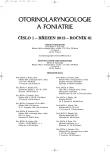Translabyrinth Craniotomy for Removal of Vestibular Schwannoma
Authors:
J. Kovaľ; S. Krempaská; L. Kaliarik
Authors‘ workplace:
Klinika otorinolaryngológie a chirugie hlavy a krku LF UPJŠ a FNLP, Košice
prednosta prof. MUDr. J. Kovaľ, CSc.
Published in:
Otorinolaryngol Foniatr, 61, 2012, No. 1, pp. 34-42.
Category:
Original Article
Overview
In a brief outline of the surgical procedure the authors present visual documentation pointing out the key moments in a correctly performed trans-labyrinth craniotomy.
Postoperative function of facial nerve, complications and postoperative steady state functions are retrospectively evaluated in a cohort of 238 patients with vestibular schwannoma, having been operated on using the trans-labyrinth approach.
The facial nerve or anatomically preserved in 93.2%. The well functioning face one year after H-B I, II was preserved in 67% and H-B I, II, III in 78%. In 12 patients the reconstruction of facial nerve was performed and the functional result after one year is H-B III-IV in all patients. When we get any response at the end of the surgery upon stimulation of the proximal part of facial nerve where in comes out of the brain stem by 0.05-0.1 mA stimuli, a normal facial function H-B I, II may be expected to occur after one year. Electroneurography is unable to safely predict a badly functioning face on the long-term basis. Postoperative complications occurred in 18%, serious one requiring early revision surgery was encountered in 2.1%.
Lethality:
one patient died a week after the surgery (0.4%), postoperative liquorrhea occurred in 9%, meningitis in 2.1%, hematoma of abdominal wall after removal of fatty tissue in 0.8%, hydrocephalus in 1.7%, transient lesions of nerves IX and X in 1.7%, and transient lesions of nerve VI in 0.4%. Balance functions after one year: 0.24% of patients suffer from mild ataxia with instability after fatigue.
In our opinion the trans-labyrinth craniotomy is a method of choice in the therapy of vestibular schwannoma in all tumors larger than 1.5 cm and even smaller ones, where criteria for saving the hearing are impossible to observe.
Key words:
trans-labyrinth approach, vestibular schwannoma, facial nerve, tumors.
Sources
1. Brackmann, D., Cullen, R., Fisher, L.: Facial nerve function after translabyrinthine vestibular schwannoma surgery. Otolaryngol. Head Neck Surg., 136, 2007, s. 773‑777.
2. Fenton, J., Chin, R., Sterkers, O. et al.: Delayed facial palsy after vestibular schwannoma surgery. Auris Nasus Laryngx, 28, 2001, s. 113-116.
3. House, W., Luetje, C., Doyle, K.: Acoustic tumors: diagnosis and management. Singular Publishing Group, Inc., San Diego, 1997, 359 s.
4. Jackler, R., Brackmann, D.: Neurotology. Mosby, St. Louis, 1994, 1464 s.
5. Kanzaki, J., Tos, M., Sanna, M., Moffat, D.: New and modified reporting systems from the concensus meeting on systems for reporting results in vestibular schwannoma. Otol. Neurotol., 24, 2003, s. 642-649.
6. Kovaľ, J., Šulla I., Krempaská, S., Kaliarik, L., Almaši, M.: Standpoint of surgeon on preservation of facial nerve function in removing of vestibular schwannoma by translabyrinthine approach. Otorinolaryng. a Foniat. /Prague/, 55, 2006, s. 199-205.
7. Kaliarik., L., Krempaská, S., Kovaľ, J.: Standpoint of the monitoring specialist on preservation of facial nerve function in removing of vestibular schwannoma by translabyrinthine approach. Otorinolaryng. a Foniat. /Prague/, 55, 2006, s. 206-212.
8. Kovaľ, J., Krempaská, S., Kaliarik, L.: Minimal retrosigmoid approach with applied endoscopy. Otorinolaryng. a Foniat. /Prague/, 58. 2009, 1, s. 8-14.
9. Kovaľ, J., Krempaská, S., Kaliarik, L.: Foramen Luschkae a indikácia neurootologických chirurgických výkonov. Otorinolaryng. a Foniat. /Prague/, 59, 2010, 2, s. 51-54.
10. Magnan, J., Chays, A., Leptre, C. et al.: Surgical perspective of endoscopy ofthe cerebellopontinne angle. Am. J. Otol., 15, 1994, s. 366-370.
11. Magnan, J., Chays, A., Cohen, J. M. et al.: Voie retrosigmoide et endoscopie de lęangle ponto-cerebelleux: indications et resultats. JFORL, 43, 1994, s. 347-352.
12. Morawski, K., Niemczyk, K., Bohorquez, J., Marchel, A., Delgado, R., Ozdamar, O., Telishi, F. F.: Intraoperative monitoring of hearing during cerebello-pontine angle tumor surgery using transtympanal electrocochleography. Otol. Neurotol., 28, 2007, 4, s. 541‑545.
13. Morawski K., Telishi, F. F., Niemczyk, K.: A model of real time monitoring of the cochlear function during an induced local ischemia. Hearing Research, 212, 2006, s. 117-127.
14. Niemczyk, K., Dubrulle, F., Vaneecloo, F. M., Lejeune, J. P., Lemaitre, L., Bruzgielewicz, A., Vincent, C.: Clinical implications of acoustic neuromas growth rate in volumetric study Ann. Otolaryngol. Chir. Cervicofac., 119, 2002, 5, s. 259-263.
15. Niemczyk, K., Vaneecloo, F. M., Lemaitre, L., Lejeune, J. P., Skarżyński, H., Dubrulle, F., Vincent, Ch.: The growth of ascoustic neuromas in volumetric radiological assessment. American Journal of Otology, 20, 1999, 2, s. 244-248.
16. Niemczyk, K. Vaneecloo, F. M., Lecomte, M. H., Lejeune, J. P., Lemaitre, L., Skarzynski, H., Vincent, C., Dubrulle, F.: Correlation between Ki-67 index and some clinical aspects of acoustic neuromas (vestibular schwannomas). Otolaryngol. Head Neck Surg., 123, 2000, 6, s. 779-783.
17. Sterkers, J. M., Sterkers, O.: Le neurinome de l’acoustique - La neurofibromatose de Type II. Les monographies du cca Wagram, Paris, 1997, 64 s.
Labels
Audiology Paediatric ENT ENT (Otorhinolaryngology)Article was published in
Otorhinolaryngology and Phoniatrics

2012 Issue 1
Most read in this issue
- What Treatment for the “Dry” Nose?
- Pharyngitis Caused by Streptococcus Pyogenes
- Bleeding after Tonsillectomy and Tonsillotomy in Children
- Translabyrinth Craniotomy for Removal of Vestibular Schwannoma
